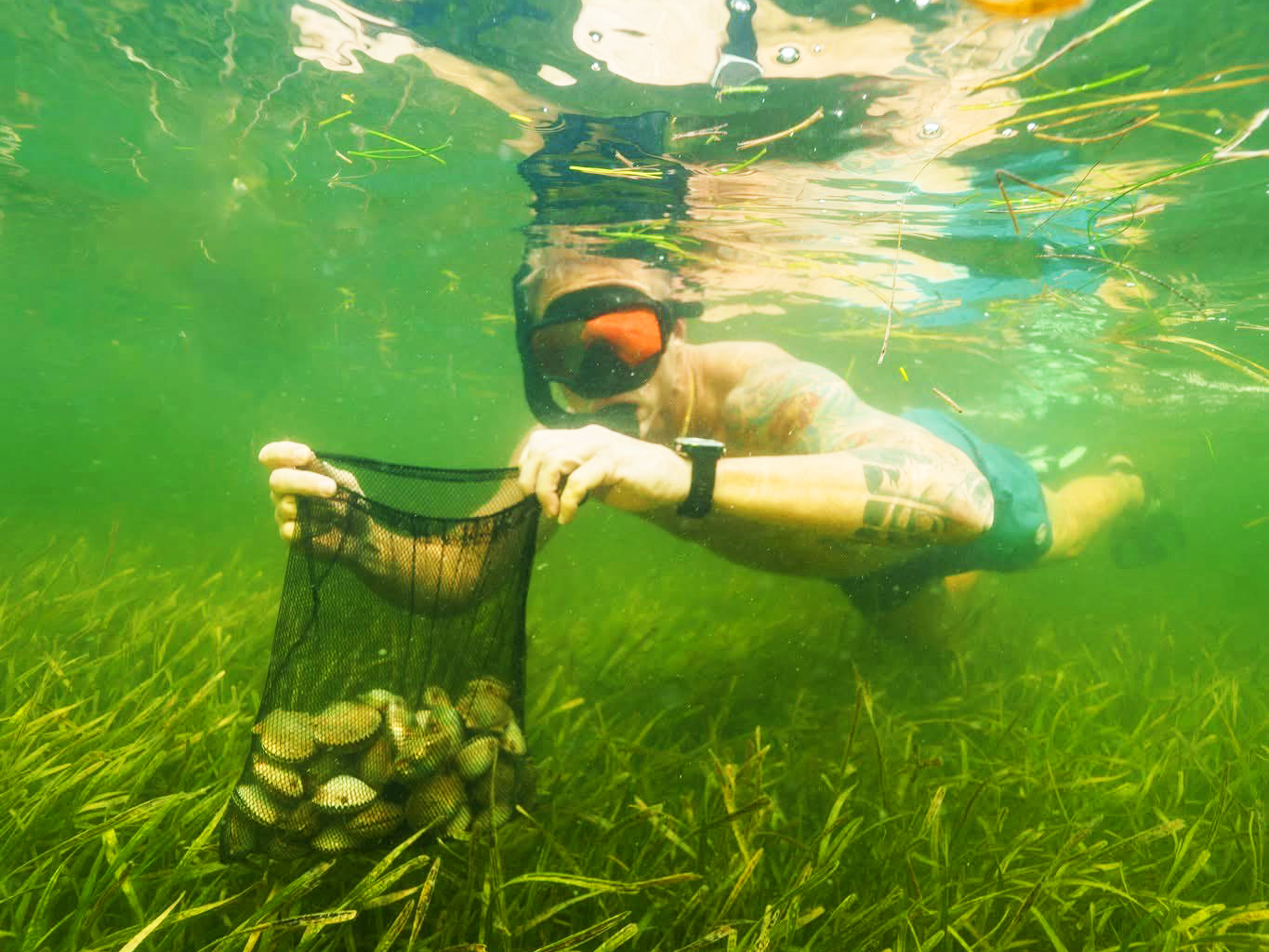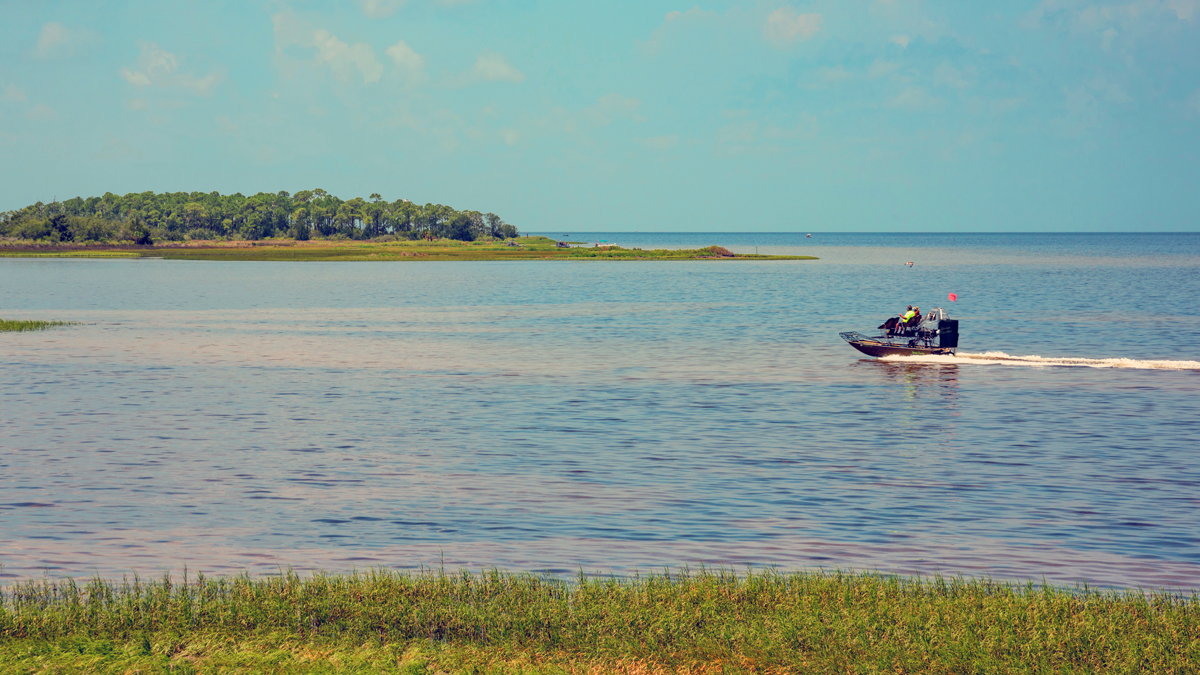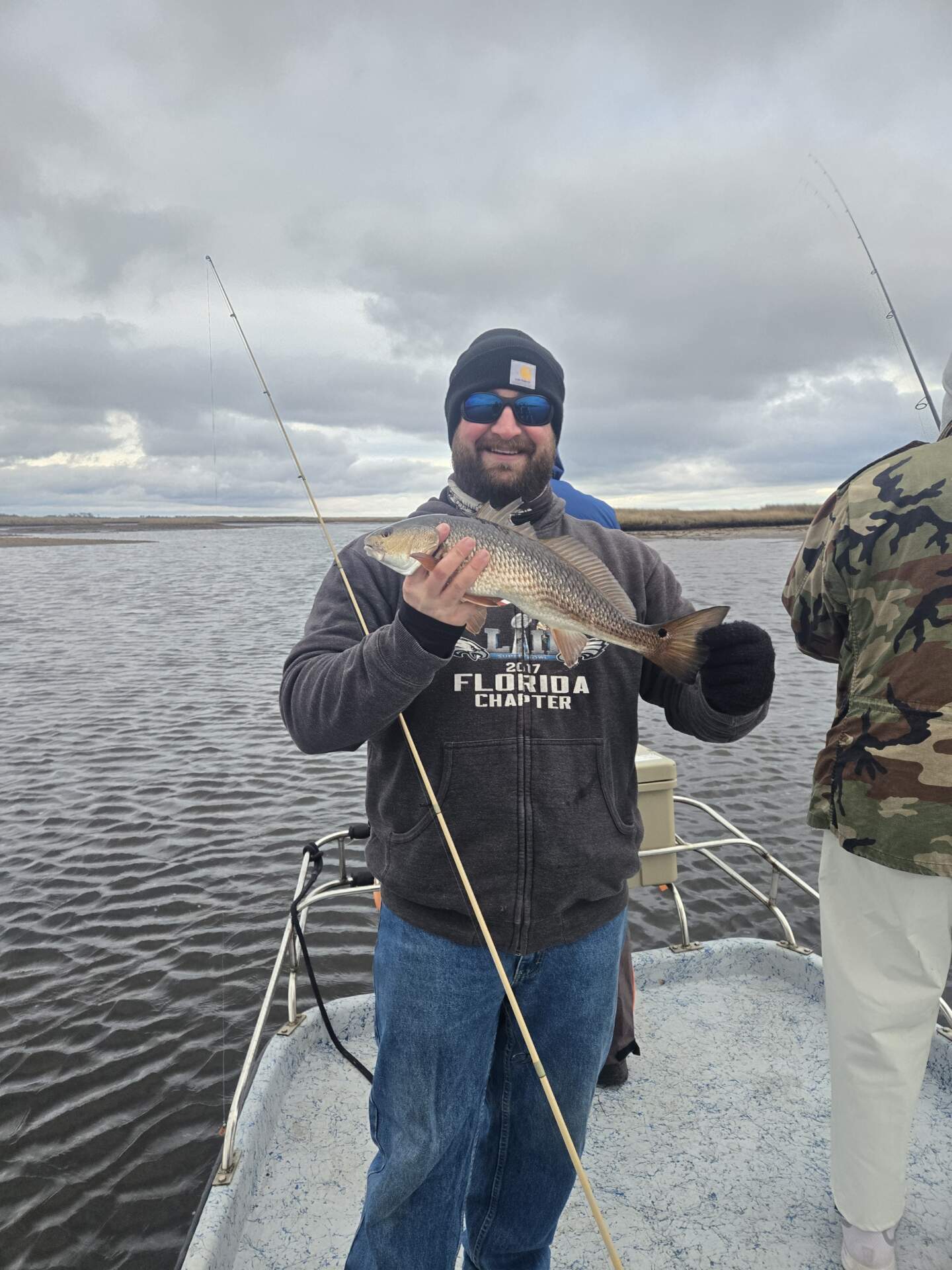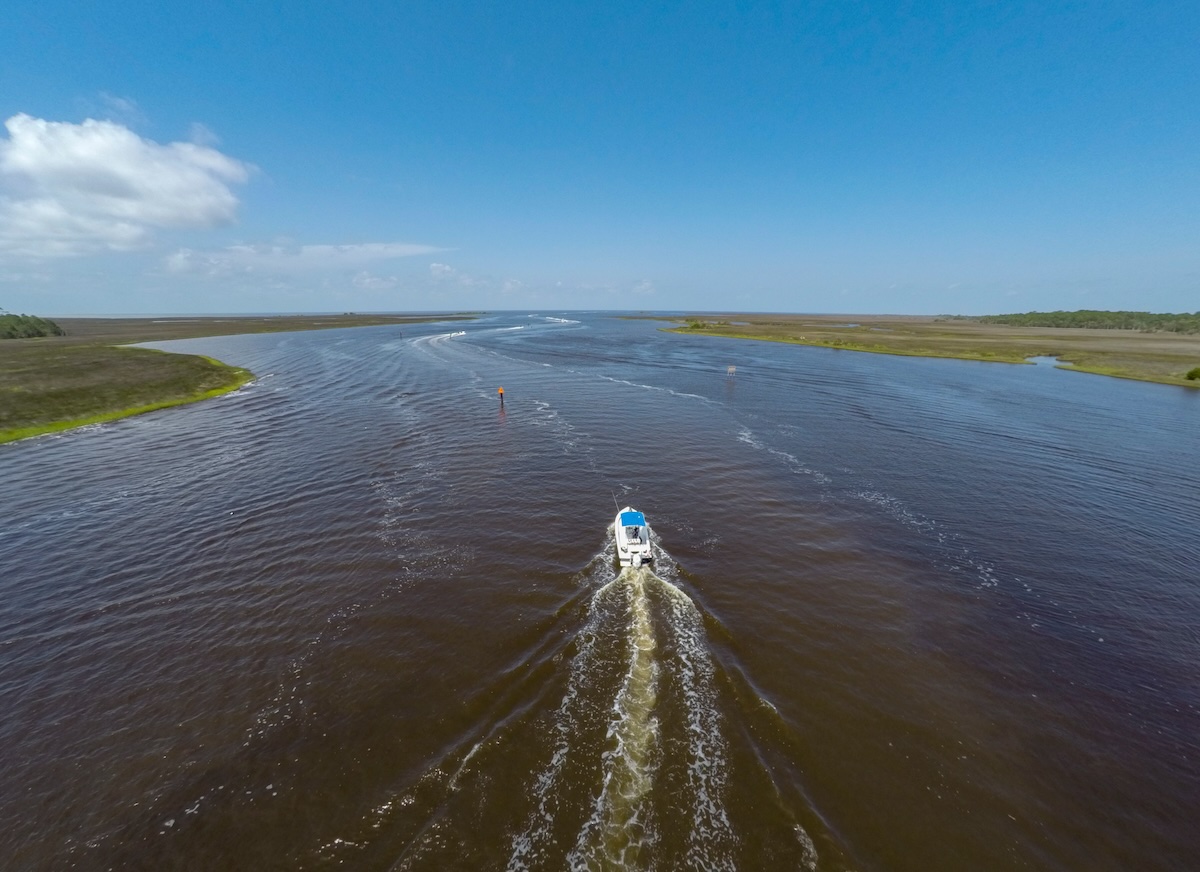Florida’s Big Bend is a region shaped by tide, marsh, and tradition. Its ragged coastline hides some of the most productive fishing grounds in the state, where creeks spill into grass flats, limestone ledges rise offshore, and life pulses through every oyster bar and mud channel, for those who know how to read it. This article explores the inshore and offshore possibilities, the seasonal thrill of scalloping, and the raw excitement of airboat fishing in the shallows.
Econfina River as a Launch Point
The Econfina River winds through a mix of hardwood forest and marsh before spilling into the Gulf. It serves as a natural highway for fishermen heading out into the wider Big Bend system. With relatively low traffic and abundant access to both structure and open water, it provides a quiet yet strategic staging point for both inshore and offshore trips.

Access and Geography
The lower Econfina is tidal and winding. On a falling tide, bars and shallows can pose challenges, but that same terrain funnels bait and concentrates predators. Short runs put you within range of productive waters around Keaton Beach to the north and Spring Warrior or Dekle Beach to the south.
Launch Strategies
- Incoming tide advantage: Leaving on an incoming tide gives more depth for exiting the river and better access to flats and creek mouths.
- Evening returns: Late-day light in the Econfina estuary offers strong sight-casting and excellent backwater conditions, especially in fall.
Inshore Fishing Overview
Inshore fishing along the Big Bend is rich, technical, and rewarding. Grass flats stretch for miles, intercut by sand pockets, oyster bars, and feeder creeks. These are not uniform meadows; they’re living puzzles, and each tide redraws the board.
Seatrout and Redfish
Spotted seatrout thrive from spring through early fall. On calm mornings, topwater plugs fished over mixed grass and potholes near Keaton Beach often draw explosive strikes. As light rises, switch to soft plastics or live bait under popping corks.
Redfish gather around structure: oyster bars, points, creek mouths, and marsh edges. The Steinhatchee area supports tailing redfish on high tides, especially in early fall. Around the Econfina, reds push into the flooded grass and creek mouths as the tide rises.
Tactics by Tide Phase
- Flood tide: Push poling or drifting the edges of flooded marshes for tailers.
- Falling tide: Focus on creek mouths and narrow funnels that concentrate bait and funnel redfish into ambush zones.
Flounder and Black Drum
Flounder stack up on transitions where hard bottom meets sand or oyster. Focus efforts near creek mouths and troughs. Slowly worked jigs tipped with shrimp or soft plastics are effective.
Black drum gather in deeper holes and around structure, particularly near Perry’s estuarine creeks. These fish respond well to natural baits like live shrimp or blue crab chunks.
Offshore Fishing Opportunities
Although this region lacks large marinas, the Big Bend provides quick access to solid offshore grounds. From Keaton Beach or Steinhatchee, bottom structure lies within an hour’s run.
Gag Grouper and Red Snapper
Gag grouper hold along limestone ledges and rock piles. Early in the season, fish stay closer to shore. As pressure builds, head to deeper breaks. Use live pinfish or cut bait on bottom rigs.
Red snapper suspend higher in the water column and take both live and dead bait. When the season is open, structure in 50+ feet often holds large schools. Chumming keeps them near the boat.
Tactics Breakdown
Anchoring and Positioning
Grouper fishing requires precise positioning. Use a GPS anchor or double-anchor setup to stay locked over ledges.
Live Bait Management
Bring a baitwell packed with pinfish, threadfins, or squirrelfish. Circle hooks and strong leader (60-80 lb) help land big fish.
Trolling Stretch Lures
In zones that transition between shallow reef and deeper ledges, trolling large diving plugs like Stretch 30s draws reaction bites from aggressive fish.
Cobia, Kingfish, and Pelagics
Cobia cruise reef edges and often surprise snapper fishermen. Keep a pitch rod ready with a bucktail jig or live bait.
Kingfish pass through during spring and fall. Troll spoons or live bait rigs around bait balls. On longer runs, blackfin tuna or mahi may appear around temperature breaks and weed lines.
Scalloping the Big Bend
Scalloping is a seasonal highlight from late June through early September. The grass flats off Keaton Beach and Steinhatchee hold dense populations of bay scallops. The activity combines harvest and tradition.
Keaton Beach Zones
Big Grass Island, Sink Creek, and the outer flats to the north offer accessible and productive scallop beds. Water depth averages 3 to 5 feet.
Timing and Techniques
Mid-morning sun creates ideal visibility. Use a snorkel, mask, mesh bag, and dive flag. Look for sandy patches within grass where scallops settle. Gloves provide grip and protect from shell edges.
- Tide tip: Incoming tides bring clearer water. Avoid overly windy days, since visibility affects success more than tide height.
Community and Culture
During the season, local ramps and marinas stay active. Scalloping suits families, though experienced divers often gather more by reading bottom changes and scallop patterns.

Airboat Fishing and Backcountry Access
Airboats reach the shallowest areas of the Big Bend. Marsh systems near the Econfina, Spring Warrior, and southern edges toward Cow Creek become accessible only by airboat.
Species Accessed
- Redfish: Schools gather in remote back lakes and creeks.
- Sheepshead: Found near isolated structure in inches of water.
- Gar and Bowfin: Hard-hitting targets in the upper stretches.
Night Missions
Nighttime airboat fishing includes flounder gigging and bowfishing for mullet and rays. Run lights over calm flats to spot fish outlines in the shallows.
- Tide criticality: Go during a low tide that begins to rise. Fish move onto warm mud flats as the water returns.
Navigating Tides and Seasons
Tide changes in the Big Bend carry scale. A foot of water vertically shifts the shoreline by hundreds of yards. Each swing alters the fishing landscape.
Seasonal Flow
Spring: Warming trends trigger trout, reds, and cobia. Bait returns and fish spread across flats.
Summer: Fish early before heat slows movement. Scalloping picks up mid-day. Offshore remains steady with the right planning.
Fall: A prime inshore season. Redfish group into schools. Trout feed heavily. Water clears and improves visibility.
Winter: Fish settle deeper. Sheepshead and black drum dominate. Use slower presentations for better response.

Making the Most of the Big Bend
- Steinhatchee is the most built-up town in the area. It offers boat ramps, lodging, tackle shops, and a strong community of guides. Its river channel is reliable, and navigation is forgiving for less experienced boaters.
- Keaton Beach is a favorite among locals. The ramp is straightforward and efficient. Scalloping sees less crowding here, and the flats are near the launch. Offshore spots are also reachable without excessive travel.
- Launching from the Econfina means keeping a close eye on tides, but the rewards are real. Expect access to quiet creeks, outer bars holding trout, and backwater marsh runs ideal for airboats.
Local knowledge matters: Knowing how each creek drains or floods changes how you fish and how far you can go.
Where the Real Gulf Still Lives
Fishing the Big Bend does not revolve around trendy hotspots or high dock counts. It is built on pattern recognition and time spent learning each bend of shoreline. A rising tide near Spring Warrior places reds in predictable spots, and a long-lingering grouper near Keaton Beach might finally break off bottom for the right bait. The reward comes to those who observe more than they chase.
For guests staying with us at Econfina Sporting Club, the gateway to this entire system lies at your dock. Drift for trout, stalk redfish, run wide for snapper, or idle through marsh grass in the quiet. Lodging, water access, and remote Gulf wilderness are all part of the experience. Book a trip with us and fish the coastline where Florida still feels untamed.



